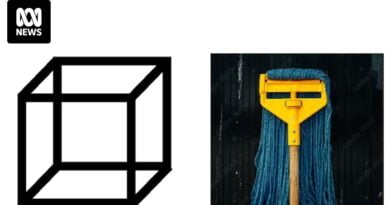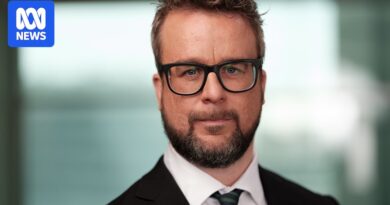Australian inventor brothers Edward and Donald Both changed lives, but ‘no-one’s heard of them’
An electric scooter doesn’t have that much in common with a humidicrib. Or a fax machine.
You wouldn’t expect someone who made heart monitors to be your first port of call when you wanted an Olympic scoreboard.
Yet all of these inventions — and around a hundred more — once came out of the same Australian factory.
They were all the creations of a pair of brothers, Edward and Donald Both.
As well as the scooter, which Yvonne Both models here, the brothers developed an electric bread delivery van. (Supplied: State Library of South Australia, PRG 1776/11/2)
Across the middle of the 20th century, the Both brothers built things to meet the challenges of the times — war machinery in the Second World War, electric vans to beat post-war rationing, sports technology for the 1956 Melbourne Olympics, and a lifesaving polio treatment to counter the devastating epidemic.
But where their name was once emblazoned on tools around the world, it’s now filtered out of sight.
Even in their home state of South Australia, the brothers’ work isn’t common knowledge — although their memory is preserved by a few dedicated museum curators and family members.
Donald Both (pictured standing) ran a company with his brother Ted which churned out inventions. (Supplied: State Library of South Australia, PRG 1776/2/20)
Who were the Both Brothers?
“Ted” and “Don” hailed from Caltowie near Port Pirie in South Australia and were the eldest and youngest, respectively, of five siblings.
Kaylene Kranz, a relative of the brothers, says their regional roots were a source of their inventiveness.
Kaylene Kranz’s mother used to babysit the Both brothers — and her husband Greg Love has helped with genealogical research on the family. (ABC News: Ellen Phiddian)
“If you’re in the country, you haven’t got the luxury of picking up the phone and say, ‘Hey, come and help,'” she says.
“If you need something, well, you adapt and you make [it].“
Ms Kranz knew both Ted and Don as a young woman — particularly Don, who she recalls as a jolly fellow.
“Ted was the put-together man and Don had ideas and ran the business side of it. But together, they were a formidable team,” Ms Kranz says.
Kellie Branson, a curator at the SA Health Museum, said the brothers’ genius came from their ability to work in tandem.
“Their brains were opposites, but they still work together to come up with these amazing inventions.”
Necessity is the mother of invention
The duo didn’t tend to invent brand new things, so much as dramatically improve existing tools. Ted once said he didn’t even like the term “inventor” – it implied their ideas had come from nowhere.
“People who imagine a person dreaming up an entire invention and making it work have the wrong idea,” he said in a 1950 interview.
“It is a painstaking process, checking each step.”
Edward Both was hailed in media as Australia’s version of the US inventor Thomas Edison. (Supplied: National Library of Australia)
This reticence didn’t stop people labelling Ted “Australia’s Edison”, particularly after his work in the 1940s.
During World War II, Ted worked on devices that measured machine gun fire, transmitted drawings and diagrams over phone lines, dried blood that could be reconstituted for field transfusions, and helped guided torpedoes.
The brothers’ electric vehicles were a response to petrol rationing. The scooter never made it to market, but Ted also developed electric vans, which were used to deliver bread until the late 1940s.
A patent of Edward Both’s electric van design. (Supplied: IP Australia)
The drawing-transmitting device, a kind of early fax machine dubbed the Visitel, found uses in confirming horse racing results.
There were more sporting innovations, first with tennis scoreboards for the Davis Cup, then the 14,000-light globe Olympic scoreboard at the MCG.
The then high-tech Melbourne Olympics scoreboard needed multiple operators to make new displays. (Supplied: Public Record Office Victoria, VPRS 10742/P0000, C2630)
Ms Kranz says there’s even a family story that they “had television sorted” before anyone else in the 1930s, only to have their plans disrupted by the war.
But the brothers’ biggest success was in healthcare.
Wooden lung and electric hearts
The iron lung worked better when it wasn’t made from iron.
The respirator, first developed in the 1920s, was a lifesaver for people paralysed by polio.
“It was very heavy, cumbersome and expensive to make and produce,” Ms Branson says.
Kellie Branson says visitors’ “eyes light up” when she shows them the wooden iron lung. (ABC News: Ellen Phiddian)
At his new wife Eileen’s coaxing, Ted decided to spend their honeymoon funds on making a cheaper version in 1937.
“They managed to do one made of plywood,” Ms Branson says. The lighter, cheaper, “iron” lung was a twentieth of the cost of commercial iron lungs.
The wooden lung helped many lives during the polio crisis. (Supplied: Welcome Collection)
Ted took the invention to London, and within a few years, there were hundreds of wooden respirators being distributed across the Commonwealth, helping surging numbers of polio patients. He was awarded an Order of the British Empire for his work.
Humidicribs, similarly, already existed in the early 1950s, when Don turned his hand to one. But his portable version could more quickly and safely encase premature babies with the right temperatures and humidity.
Don (pictured) worked on the incubator while Ted was setting up a factory in Sydney. (Supplied: State Library of South Australia, PRG 1776/2/6)
Then, there are the electrocardiograph (ECG) machines. Doctors had known since the 19th century that placing electrodes over a patient’s heart, and recording the signals it emitted, could give vital information about a patient’s heart health.
By the 1930s, ECGs were accurate enough to diagnose patients — but getting the graphs required an arduous film-developing process, which could take weeks.
The Both brothers figured out how to make instant readers: first with glass discs, then with paper and ink-dipped styluses marking out tiny graphs.
The Both brothers’ portable ECGs condensed electrocardiography into one box. (ABC News: Ellen Phiddian)
“You could use the microscope on top of the machine to view the results instantly,” Ms Branson says.
They could also be transported to hospital bedsides, or even over bumpy roads to the patients’ homes.
This ECG was designed to write with a heated stylus on waxed black paper, an innovation thought up by a Both apprentice. (ABC News: Ellen Phiddian)
The brothers also worked on electroencephalographs (EEGs) for measuring brain activity.
Ms Kranz, who worked in neurology, found herself using EEG equipment designed by the Both brothers years later — alongside a family cousin who’d stayed with the business.
“That was nice, to be working with a Both invention in a Both environment.“
Making healthcare stylish
From the polished wooden frames to the delicately printed labels, much of the Both equipment is aesthetically pleasing to look at. It’s a world away from the bright, boxy plastic of modern medical equipment.
The ECGs fit right in to the halls of the library at the South Australia Parliament, where librarian John Weste has put some of the Both equipment on display.
John Weste at the Parliamentary Library of SA which is open for members of the public to visit in non-sitting weeks. (ABC News: Ellen Phiddian)
“I love the design,” Dr Weste says.
“It’s so beautifully executed — even the carrying cases with the herring bone wood patterns.”
Packed into their cases, the early ECGs look less like doctors’ tools and more like vintage sewing machines. Ms Branson suspects this is deliberate.
Both equipment was “beautifully constructed” as well as designed, according to Dr Weste. (ABC News: Ellen Phiddian)
“I think they did design it on the look of some old sewing machines,” she says.
For patients who’d never seen an ECG before, a more familiar piece of equipment might be less foreboding.
Other pieces might be mistaken for old radios.
“It wouldn’t seem like they were getting a procedure or a reading. It just looked like the radio was next to their beds,” Ms Branson says.
“I think putting patients at ease was a major factor in some of these designs and inventions.“
The smart cases conceal more complicated interiors. (ABC News: Ellen Phiddian)
Ms Kranz finds this suggestion likely, remembering the beauty of Don and his wife Yvonne’s Kensington home on her visits.
“They had a lovely house, and we were always given tea out of beautiful cups in the sitting room,” she says.
“So yes, I think so that it wasn’t just ‘OK, let’s sort this’, [it was] ‘let’s make people comfortable while we’re making them well.'”
A forgotten chapter
The brothers sold their company to Drug Houses of Australia in the 1960s, but they kept tinkering well into retirement. Ted died in 1987 and Don died in 2005.
Ms Branson, who’s been collecting Both equipment for the health museum for years, recently travelled out to Ted’s grave in Victoria.
“It’s a humble little plaque. No mention of his inventions. It just says: ‘Ted Both, OBE, and his dates.'”
Eventually, more company acquisitions and the pace of medical research took the Both name off equipment.
The Gothic Both logo, seen here on a nerve stimulator, is a nod to the family’s German ancestry. (ABC News: Ellen Phiddian)
Dr Weste, who’s been showing the Both equipment to visitors to the South Australia Parliament, says people are surprised to learn the inventions originated in the state.
“No-one’s heard of them. And that’s the great tragedy of it,” he says.
This is partly why the health museum loans some of the Both equipment out.
“Otherwise, these stories will be hidden away,” Ms Branson says.
“We want these people to be out in the light.”
Ms Kranz would like to see the brothers’ work featured in local school curriculums. (ABC News: Ellen Phiddian)
Ms Kranz has told her grandchildren about her clever cousins, and she wants them to be more widely known too — but not just them.
She says South Australia has a host of other under-recognised inventors.
“This state has got people who have done amazing things, women and men.“
Ms Kranz hopes the Both equipment on display will show people how much medicine has changed in the span of less than a lifetime.
“We have our MRIs and our CTs, and our big, whiz-bang machines that twiddle around and go ping, but they managed to diagnose without that in the early days, with very basic stuff.”





